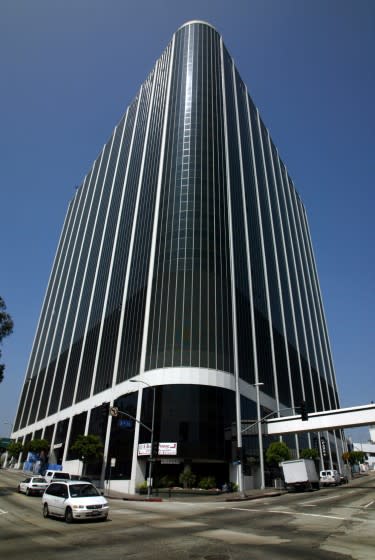Editorial: LAUSD wants to sell its headquarters. Good

It looks like Beaudry might go on the market. And while that’s a good thing, it’s just a first step toward bringing the Los Angeles Unified School District closer to the people it serves.
For anyone remotely familiar with L.A. Unified, saying anything beyond “Beaudry” is unnecessary. For the rest: It’s the behemoth building that looks like a giant air conditioner at 333 S. Beaudry Ave. in downtown Los Angeles. The district purchased it almost 20 years ago to serve as its headquarters, and as much as the edifice might have made sense at the time, its era is past. Few people would mourn its loss.
When it was acquired for $75 million (with tens of millions of dollars more spent on renovation), the district was nearing its 2002-03 peak of close to 750,000 students. Administrative offices were scattered among several buildings; the land under those buildings was needed to build new schools. The district was so crowded then that teachers had to move themselves and their supplies from one classroom to another. There weren’t enough classrooms for each of them.
But Beaudry served as more than office space. The triangular 29-story structure also became a symbol of centralized control of the district, which itself was seen as an inaccessible behemoth, and its top-down management — berated by critics as bloated, resented by teachers, and seen as remote and forbidding by many parents. Parking is limited and costs money that not all families have. It is centrally located, but still hard to get to from most places within the district.
The building exemplified the management style of its superintendent back then, Roy Romer, a former Colorado governor who was accustomed to running things from a state Capitol building and who expanded central administrative staffing. But it also in ways mirrored the needs of the time. Smaller class sizes in primary school had forced the district to hire hordes of uncredentialed teachers who didn’t know how to go about imparting the secrets of reading to their young students.
Romer oversaw the implementation of the heavily scripted Open Court reading program throughout the district. It allowed newbies to cover the basics by reading the scripts, but more experienced teachers saw it as squashing the methods they had developed over years. They resented the coaches Romer hired to oversee their work, saying the interference flattened any attempts at instructional creativity, and they had a point. But Romer, trying to ensure that all students received at least a modicum of reading instruction, was dealing realistically with the conditions at the time.
That reality has changed. The district now instructs fewer than 500,000 students, a third less than it used to. It has underutilized buildings rather than overcrowded ones. There’s a new realization that giving teachers high-quality training results in better instruction than giving them orders from the top (though the district hasn’t gotten to the point of offering that excellent training), and that individual schools are best suited to making the decisions that will help their students. District administration — which has shrunk in recent years — ideally would support those decisions rather than dictating its own.
Current Supt. Austin Beutner has long expressed more interest in sending administrative staff closer to school campuses. And the pandemic has taught L.A. Unified, along with other employers, that many tasks, though perhaps not teaching, can be accomplished effectively from the most decentralized locations of all: employees’ homes. Beyond that, selling or leasing the central office might bring some relief to the district’s pandemic-caused financial strain. The board is discussing that possibility along with other potential property sales, though relocation of administrative offices would be a long way off.
There would be little grief in saying bye bye Beaudry. But if L.A. Unified truly wants to redefine itself as welcoming to families, students and teachers, it needs to do more than put up a for-sale sign and redistribute about 3,000 employees.
In truth, there is no convenient location within sprawling L.A. Unified for school board meetings, no place easily accessible to most or even a sizable minority of families. The board has long needed to circulate, holding meetings in various locations that give people in those areas a chance to participate. And it needs to reschedule some of those meetings for evenings when students and teachers aren’t in class, and when more parents are likely to attend.
Of course, digital meeting rooms could bring parents to meetings and provide them with opportunities to voice their questions and opinions. But there also is power in showing up in person once the coronavirus no longer makes that inadvisable.
Creating a more responsive and accessible education institution revolves around how L.A. Unified treats people, not a building.
